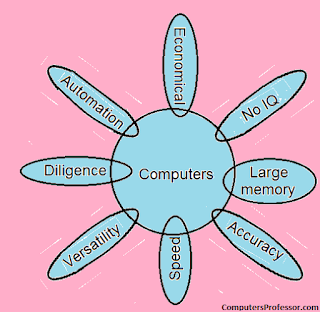Explain various characteristics and limitations of a computer ?
https://www.computersprofessor.com/2016/04/characteristic-limitations-computer.html
A computer is equipped with number of characteristics that helps to perform different tasks more efficiently and effectively.
Characteristics
of computers
|
We have seen that a computer is an
electronic device that performs a function based on a given set of
instructions known as a program. A computer accepts data, processes it, and
produces information. Here, data refers to some raw facts or figures, and
information implies the processed data.
The important characteristics of a
computer refer to figure are.
Speed
:
Computers can
perform millions of operations per second, which means that data that may
otherwise take many hours to process is output as information in the blink of
an eye. The speed of computers is usually given in nanoseconds and
pico seconds, where 1 nanosecond = 1 ´ 10–9 seconds and 1
pico second = 1 ´
10–12 seconds.
Accuracy
:
A computer is a
very fast, reliable, and robust electronic device. It always gives accurate
results, provided the correct data and set of instructions are input to it.
This clearly means that the output generated by a computer depends on the
given instructions and input data. If the input data is wrong, then the
output will also be erroneous. In computer terminology, this is known as
garbage-in, garbage-out (GIGO).
Automation
:
Besides being
very fast and accurate, computers are automatable devices that can perform a
task without any user intervention. The user just needs to assign the task to
the computer, after which it automatically controls different devices
attached to it and executes the program instructions.
Diligence
:
Unlike humans,
computers never get tired of a repetitive task. It can continually work four
hours without creating errors. Even if a large number of executions are
needed, each and every execution requires the same duration, and is executed
with the same accuracy.
Versatile
:
Today computers are
used in our daily life in different fields. For example, they are used as
personal computers (PCs) for home use, for business-oriented tasks, weather
forecasting, space exploration, teaching, railways, banking, medicine, and so
on, indicating that computers can perform different tasks simultaneously.
Memory
:
Computers have
internal or primary memory (storage space) as well as external or secondary
memory. While the internal memory of computers is very expensive and limited
in size, the secondary storage is cheaper and of bigger capacity.
The computer stores a large amount
of data and programs in the secondary storage space. The stored data and
programs can be retrieved and used whenever required. Secondary memory is the
key for data storage. Some examples of secondary devices include floppy
disks, optical disks.
When data and programs have to be
used, they are copied from the secondary memory into the internal memory,
often known as random access memory (RAM).
No
IQ :
Although the
trend today is to make computers intelligent by inducing artificial
intelligence (AI) in them, they still do not have any decision-making
abilities of their own. Thus, their IQ level is zero. they need guidance to
perform various tasks.
Economical
:
Today, computers
are considered as short-term investments for achieving long–term gains. Using
computers also reduces manpower requirements and leads to an elegant and
efficient way of performing various tasks. Hence, computers save time,
energy, and money. When compared to other systems, computers can do more work
in lesser time.
|
LIMITATIONS OF COMPUTERS:
1. Computer is a machine and therefore it needs human skills to operate.
2. It does work on its own and need set of instructions to be given clearly without any ambiguity.
3. It does not have natural intelligence and hence it has to be instructed each and every step.
4. It does not learn by experience like human beings.
5. Computers will not have any mind and cannot take any decisions by its own. Thus, they are purely dependent upon the user’s capability.


